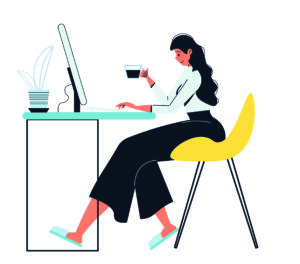By Marty Lamers
It’s fair to say that the Coronavirus pandemic has changed all of our lives. Social distancing directives and safer-at-home orders have disrupted daily routines in ways that would have been unimaginable just a few short months ago.
Over the past few months most of us have found ourselves at home, turning into teachers, chefs, DIY experts…and in more restless moments, we are even makeshift entertainers. A healthy percentage of us are also currently, or very soon going to become remote workers, trying hard to adapt to a unique and deceptively familiar workplace environment.
At first, working from home might seem like a small and fairly simple transition to make. It might even feel like a vacation of sorts. After all, you get to stay at home all day. No more morning commute, no dress codes, and plenty of time for breaks. You get to snack at your desk, chat on the phone, and the boss won’t be hovering around your personal space all day micromanaging your workload.
What could possibly go wrong?
The truth is, even under “normal” circumstances, working from home can present some real challenges. Remote workers have to master a unique learning curve, and first–timers often find it more difficult than they originally suspected. The convenience and benefits of working from home can be deceptive. Without the structure and mandates of a traditional workplace environment, it can become difficult to manage your workday efficiently. Productivity can suffer, and tensions can build with fellow employees, family members and/or roommates.
If your office has been wholly or partially closed and you now find yourself working from home more often, we’ve put together some simple tips to help make the transition from office dweller to remote worker much easier and more successful for you.
Dress for Work
The first casualty of remote working is personal appearance. It is all too tempting to simply roll out of bed, pour a cup of coffee, and spend the entire workday in your pajamas. But that is a temptation that you have to resist…it almost always results in a slow start to things and causes a precipitous drop in personal productivity.
It may seem counterintuitive, but when working from home it is always important to dress for the office – even if that office is the family den, basement or rec room.
The simple act of dressing for work signals the start of the day, and it serves to focus the attention and get you ready for the work ahead. It helps to preserve a sense of time, schedule and normalcy, all of which are vitally important when your work schedule is no longer so rigidly defined by a time clock and specific location.
Normal morning routines should be retained as a matter of course. Take your daily shower as always, brushing your teeth and combing your hair. Get dressed as if you are expecting company or holding a meeting. These common, simple routines help to set the stage for the normal day ahead. They can also help you to stay alert, focused and healthy, and keep you prepared in the case of any unscheduled visits or impromptu video chats.
Create and Maintain a Dedicated Workspace
 One of the bigger challenges remote workers face is maintaining a distinct separation between their home life and their work responsibilities.
One of the bigger challenges remote workers face is maintaining a distinct separation between their home life and their work responsibilities.
Normally, there is a very real physical and temporal barrier that enforces a clear-cut separation of “work” and “home.” You leave home and head to the office each morning, where the job then commands your full attention. At the end of the day you pack up your work and head home, physically and mentally removing yourself from the concerns of the office.
When you are working from home those mental and physical barriers tend to drop away and the lines begin to blur. If you are not careful, it is all too easy for the details of work and home to get mashed together, which can feel quite overwhelming.
If you have never worked remotely before, you will need to stake out a designated area of your home and make it your de facto office for the duration of your company’s safer-at-home orders. Ideally, it should be a separate room that can be made into a dedicated workspace. But even if you are working from an apartment, efficiency or flat you should try to create a dedicated work area that will allow you to avoid distraction or interruption by family members or flat mates.
The ultimate goal is to be able to clearly define a ‘work zone’ and a ‘home zone’ so that you can effectively leave the ‘office’ when the day’s work is done.
Maintain a Specific Work Schedule
In addition to dedicating a specific workspace within the home you will also need to establish and adhere to a clearly defined work schedule. Creating the normalcy from a scheduled and regular routine helps focus the mind and makes it easier to transition from work–mode to home–mode whenever needed.
One of the keys to successfully keeping a consistent work schedule is simplicity. If your normal office work schedule is 9–to–5, Monday thru Friday, keep to that simple routine. Grant yourself periodic breaks during the workday, just as you would have in a more traditional office environment. No need to get fancy about anything.
If you live with others, make sure they know and respect your work schedule. When appropriate, they should behave as if you were at the office and only interrupt your work routine when absolutely necessary. No need to take it to any extreme, but family and roommates should know to avoid disturbing your worktime simply because you are at home, physically, and it’s convenient.
Through maintaining a dedicated work schedule, you can reduce many of the distractions that often come with working from home, making it easier to remain focused and productive throughout every workday. Knowing that the day starts at 9 and ends at 5 is more powerful than you think.
Find Ways to Transition in and out of Work Mode
 Most of us develop daily routines that help us mentally prepare for the workday ahead. It might be listening to an audiobook on the drive into the office or doing the newspaper crossword on the train into the city. These may seem like mostly inconsequential moments, but they do allow us to make a smooth mental transition from the tranquility of home life into the rigors of work mode.
Most of us develop daily routines that help us mentally prepare for the workday ahead. It might be listening to an audiobook on the drive into the office or doing the newspaper crossword on the train into the city. These may seem like mostly inconsequential moments, but they do allow us to make a smooth mental transition from the tranquility of home life into the rigors of work mode.
When you are working from home it is important to maintain these daily rituals whenever possible. Set aside time each morning to read the news, listen to the radio, or jog around your neighborhood. Try to recreate your regular morning routine, albeit on a smaller schedule and perhaps in a different location, to get mentally prepared for any upcoming day’s demands.
You can do the same for what was once the evening commute. Look for ways to maintain or recreate your end–of–workday routine so that you can make a clean break from office mode and return to the different mental and physical rhythms of a typical home life.
Maintaining a healthy home working environment requires respecting the routines employed to get ready for work or to wind down from it. These transitions will help you define and clearly see the differences between work and personal time – differences that are harder to find without a traditional office in the daily mix.
Keep in Touch with Co-Workers
A large part of the traditional office experience is found through the camaraderie we share with our fellow employees. Vital personal connections can be lost when we all work in isolation, so it is important to take deliberate steps to keep those lines of communication open and active.
During your daily work sessions remember to connect with work associates as often as possible – perhaps even a little more often than you normally would. If you are thinking of texting or emailing a question to a fellow employee, you might call them directly, instead. Use Zoom, Skype and other common office tools to stay in touch, visually. Take advantage of meetings, both scheduled and pop-up, and use them to interact in real-time with co-workers and others.
Your willingness to connect and interact via web-based tools should also extend beyond your daily work schedule. Set aside time to virtually socialize with your friends, loved ones, relatives AND your fellow employees. Under the current circumstances, worry is a common feature of everyone’s day. Simply reaching out to friends and co–workers and staying in close contact is a very good way to improve mental health and share progress in an abnormal and often stressful situation.
This May Be Temporary, Maybe Not
 No one knows for certain how long we will need to maintain social distancing and safer-at-home directives. It is possible that many of us will be working from home for some time to come, while others may never return to a traditional office space. Predicting the future is certainly harder to do with the year 2020 in our shared experience, but it is safe to guess that it will be different than in years past.
No one knows for certain how long we will need to maintain social distancing and safer-at-home directives. It is possible that many of us will be working from home for some time to come, while others may never return to a traditional office space. Predicting the future is certainly harder to do with the year 2020 in our shared experience, but it is safe to guess that it will be different than in years past.
There will come a time when the crisis aspect of the pandemic is finally over, and we enter the “new normal” that you hear about in the media outlets today. The complexion of the new normal is hard to pin down just yet and is still morphing for sure – but it will undoubtedly contain more work-from-home participants than ever before in our world’s history.
The good news is that working from home is not as challenging as it might feel at first, and in time, it can be a very beneficial way to do business. By following the simple steps outlined in this article, any employee relocated to their home office can find a way to avoid distraction and increase overall happiness, and continued productivity.





